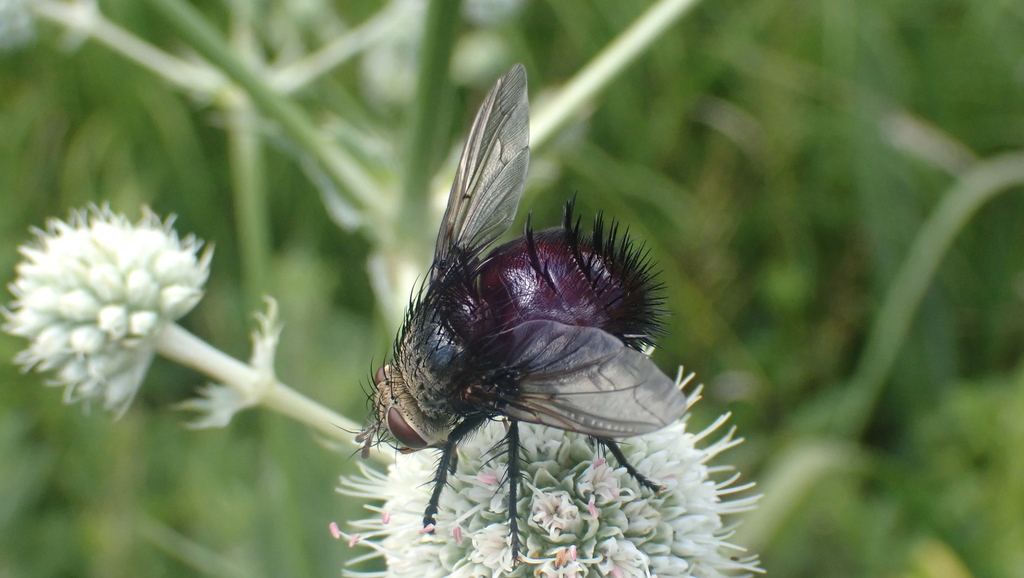July 2022 Recent Additions to the Known Biodiversity of the Berea College Forest
July 2022
Five-Banded Thynnid Wasp
Spotted feeding on the nectar of Rattlesnake master flowers. This species seems to be fairly uncommon in KY but it is probably just underreported.

Clubbed Mydas Fly
This is one of the largest flies in KY with wingspans of over 2 inches. This species mimics wasps so it has very few predators. This one was spotted by Berea College student Edie Jo Wakin.

Bog Lygropia Moth
Another new species added by Edie Jo Wakin. This moth was photographed during National Moth Week. As the name suggests this species lives in boggy wet areas.

Eastern Amberwing
Another species first added by Edie Jo, this dragonfly is a great example of a relatively common species that just doesn’t get reported often due to its small size and difficulty to photograph without a telephoto lens.

Dark Phalaenostola Moth
It may not be the prettiest moth out there but it has its charm. The larval host plant of this species is still unknown.

Juriniopsis adusta
This is a species of tachinid fly that parasitizes butterfly and moth caterpillars. This one in particular focuses on tiger moths and skipper butterflies.

Poison Ivy Leaf-miner Moth
Many of the Leaf-miners can be identified by the “tracks” that the caterpillars leave behind while feeding inside of leaves. As you might imagine these are very tiny moths.

Hidalgo Mason Wasp
Found feeding on the nectar of Rattlesnake Master flowers. This species builds its nest in dirt banks and sometimes in the nests of other wasp species.

Fiery Skipper
This is a common species but it hasn’t been documented until this month. Most likely overlooked due to its similarity to other skipper species.

Tulip-tree Silkmoth
Photographed by Kayla Zagray during one of our creepy critter night hikes. This one had a bad wing but it could still fly okay.

Lanceleaf Frogfruit
This species has been found in the Berea College Forest before however, it made its “iNat debut” this month thanks to Kayla Zagray snapping a photo and uploading it to iNaturalist.

Funereal Duskywing
Not only is this species a first for the project it’s also one of the first observations of this species in the state! This species normally lives around Texas and Mexico but vagrants end up in the eastern US from time to time. This one was nectaring in our pollinator garden.

Efferia aestuans
This new species of Robber Fly was found hanging out on the side of the building.

Delta Flower Scarab
This beetle gets its common name from the triangle on the thorax that looks like the Greek letter delta.

Sumac Gall Aphid
Female aphids lay an egg on the bottom of a sumac leaf which induces the leaf to form a gall around the egg. The aphid hatches and reproduces asexually while still inside the gall. In late summer winged females leave the gall and establish new colonies in moss.

Secondary Screwworm Fly
The larvae infest existing wounds and can be a threat to livestock. However, they are also important decomposers of carrion so they aren’t all bad.

Prairie Dock
This is another species that was hiding in plain sight, found just a few feet off of a trail.

Showy Emerald
The larvae of this little green moth feed on Sumac and Poison Ivy.

Zethus spinipes
A type of potter wasp that builds cells for their eggs that look like small pots.

Red Shouldered Bug
The species name for this bug is “haematoloma” which is Latin for blood-fringed … I guess red-shouldered is a little less threatening.

Orange-legged Furrow Bee
This species has the interesting habit of being eusocial in areas with warmer climates and at low elevations and being solitary in high elevations and areas with colder climates.

Tall Tick-Trefoil
Another fairly common species that has just been overlooked due to the similarity to other species in the same family.

Dark-veined Longhorn Bee
Found pollinating one of the native sunflowers in the prairie.

Silky Striped Sweat Bee
We haven’t been able to confirm this one down to species for sure just yet. If this is the correct species it would be one of or possibly the first record in KY.

Round-leaved Boneset
Prefers to grow in wet areas, this one was found along the new burn trail.

Delightful Dagger
Another moth species found by Edie Jo during National Moth Week.

Dicerca lurida
The larvae of this beetle feed on Hickory trees so it makes sense that we found it on the fence under the Hickory tree by the entrance to the trails.

Promiscuous Angle
Another Moth Week addition by Edie Jo.

Golden-reined Digger Wasp
The gold highlights on this wasp were stunning in the sunlight. This picture doesn’t show just how shiny this wasp was.

Spotted Thyris Moth
Spotted nectaring on Rattlesnake Master Flowers, the Larvae of this moth feed on Clematis.

Leucospis affinis
This is a species of parasitoid wasp that is a parasite of many bee species… a video of one laying eggs can be found here https://www.youtube.com/watch?v=xcMcXH0V7Qo

Physocephala sagittaria
It looks a lot like a wasp but it’s actually a fly.

Belvosia borealis
Another member of the Tachinid flies that parasitize caterpillars.

Stizus brevipennis
A large wasp species that I believe is the first confirmed record in Kentucky. The species name brevipennis refers to its short wings.

Wainscot Grass-veneer
Small unassuming moth that upon a closer look has a really neat pinstripe pattern.


